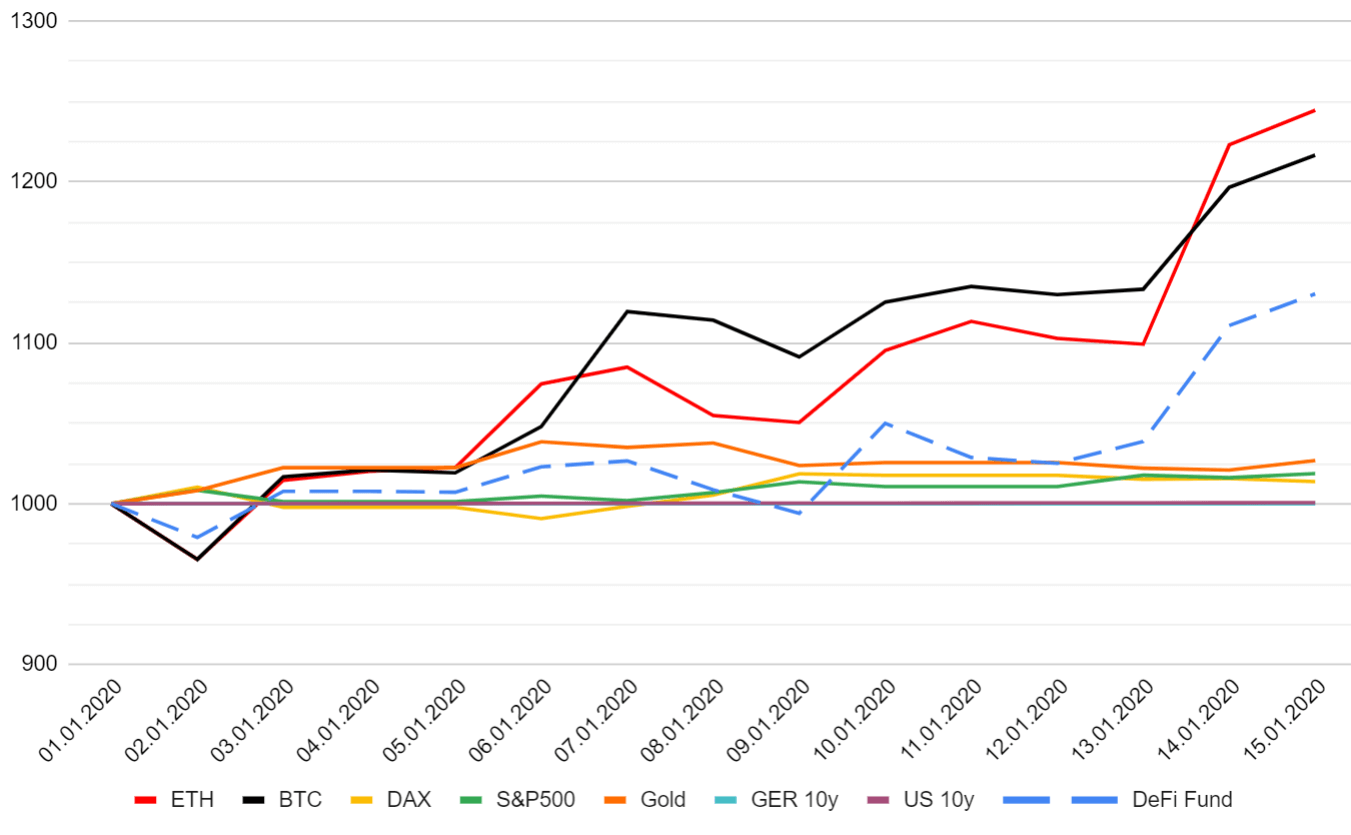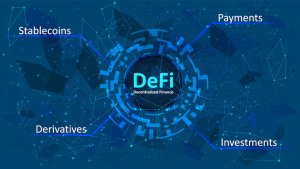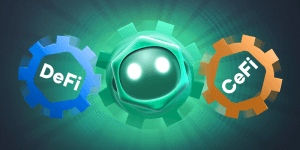DeFi. The newest buzzword in blockchain and crypto. What is it, and why should you pay attention? You should because it’s an exciting new way to interact with and make money out of crypto if you play your cards right.
The crypto world has been taken by DeFi because it represents a bold new departure from the world of centralized finance. It also has perks, like instantaneous transactions and anonymity. Bain Capital Ventures partner Salil Deshpande believes DeFi has caught on fire because people have in them “a libertarian streak.”
But what does DeFi investing entail and what should you know before you join the bandwagon?
What Does it Mean to Invest in DeFi?
Still an entirely new field, many people may be at a loss at what it actually means to invest in DeFi. You probably hear terms like ‘staking’ and ‘decentralized lending’ being thrown around, or wonder what type cryptocurrencies make the rounds in the world of DeFi. If that’s you, we’ve got you covered. Below, we’ll cover the basics of investing in DeFi and then examine the do’s and don’t’s of the same. Remember DeFi is based on crypto, and so the inherent risks haven’t gone anywhere.
DeFi Investment Opportunities
Now, investment in DeFi isn’t a lot different from traditional investment, but a few unique aspects make it stand out.
For instance, traditional lending involves the lender giving money to the borrower – with them (the borrower) making the promise to return the money with interest.
This is how decentralized lending works as well, except this time, blockchain-based smart contracts lock in collateral from the borrower and automatically delivers interest to the lender periodically according to the terms of the contract.
Then there’s staking. In traditional finance, individuals usually deposit money to institutions such as banks and credit unions and these institutions use this money to maintain liquidity and sufficient cash reserves. In DeFi, this process of buying and depositing digital assets into a platform’s account is known as staking. Such platforms need the funds to lend out to other users (borrowers), and to help maintain and secure the network.
The Do’s of Depositing in DeFi
DeFi Investing can be incredibly lucrative, but you can also potentially lose everything especially if you go in blindly. Here’s what you should definitely do before putting your money up.
#1. Do Your Own Research (DYOR)
The decentralized finance world is rife with scams and frauds. Scammers usually take advantage of the novelty of the tech to rip off unsuspecting investors. But that doesn’t mean there’s no way you can identify a scam.
The quickest way to do so is to type the name of the project on Google along with the word ‘scam.’ The reason for this? If the project is a scam, chances are other people have already pointed that out. Whether it’s on cryptocurrency forums, Reddit, Twitter, or even Quora, it’s most likely certain the thought has been floated. And often in crypto, if it walks like a duck…
Also, DeFi protocols are based on open-source code. That means anyone can check ‘under the hood’ and identify anything that’s off. If you’re a programmer who’s familiar with smart contracts, then you can definitely examine the assemblage of what’s underneath.
#2. Look at Reviews
This is another way to establish the credibility of a DeFi project, and it involves looking at what other people are saying. This starts by looking at audit reports. Any DeFi project worth its salt will invite industry auditors such as ChainSecurity, Quantstamp, Trail of Bits OpenZeppelin, e.t.c. to conduct a manual audit of the project.
The next thing to check out is what everyone else is saying, including the developers themselves, on their website and other forums. Look at the project’s social media handles and see the comments on posts. And if a project is lacking a social media presence, that right there is a big flashing red sign.
Other helpful places to look at websites that cover the world of DeFi: DeFi Prime, DeFi Pulse, and DeFi Market Cap. These websites can provide valuable insight into a project’s cred. The key here is to rely more on independent sources, rather than on info touted by the project’s team.
#3. Check Etherscan
EtherScan is a blockchain explorer that allows you to explore Ethereum blockchain and ‘scan’ for transactions, prices, tokens, and pretty much all activity happening on Ethereum. Remember that just because a smart contract/token is verified by Etherscan doesn’t mean it has no vulnerabilities or is not a scam. It means that the contract is available for public evaluation and is not in danger of being dishonestly altered. In other words, the code that you see (and have examined) is the code that you get when using the smart contract.
Besides, Etherscan has recently implemented Every Transaction Hash Protect (ETHProtect), a service through which users can report any suspicious or fraudulent activity on Ethereum. Through ETHProtect, it’s easier for users to recognize tainted incoming funds, and the system can usually trace such funds to the origin. Usually, tainted funds would originate from phishing, hacks, scams, exploits and suspicions, and fraudulent activities.
Such reports will be analyzed by the in-built Taint Inference Analysis Engine, and if confirmed to be indeed fraudulent, the address page will receive a flashing ‘Red Shield’ icon that allows users to avoid the sources of such funds.
If you start coming across tainted addresses when investigating a smart contract, then you know there’s a problem. As such, avoid going to the project’s website or interacting with their products.
#4. Look out For Fakes
The majority of DeFi tokens use Ethereum-based tokens to carry out their operations. However, an unsuspecting newcomer might not be able to check the difference between a legit token and a fake one. Scammers will usually create a project with a genuine-sounding name such as DeFi token or DeFi coin. A name like that would likely raise eyebrows in an experienced investor, since ‘DeFi’ is a general word, and it’s unlikely for any project to brand themselves as such. But what would a newcomer know?
A few simple steps may be all it takes to establish whether it’s a legit thing or not. Search the project on GitHub and see whether there are any meaningful discussions surrounding the project. Also, where do the project’s links lead to? If it’s a dead link, then that should have you scurrying in the opposite direction. Another way to tell a token’s standing is to check the kind of exchanges it’s listed on. If a token is listed on a few nondescript exchanges, that’s a red alert. Also, fake tokens will usually be listed on decentralized exchanges because there’s no regulation going on there. Stay on the lookout for these kinds of things.
The Don’t’s
Now that we have examined what you should definitely do, let’s take a look at what you shouldn’t.
#1. Don’t Invest Money that You Can’t Afford to Lose
This is the number one commandment of crypto and DeFi investing. The ‘why’ is obvious: crypto markets are highly volatile. You can gain or lose massively within an hour. The hype and allure surrounding DeFi protocols can trick you into thinking it’s all rains of cash, rainbows, and unicorns.
This isn’t to scare you off from investing in DeFi. DeFi can be a great way to multiply your portfolio and secure your financial future. But you need to proceed with caution, that’s all.
#2. Don’t Be Careless
Decentralized finance is all about being your own bank. This has several implications. One of these? The security and safety of your funds are solely on you. And since you are in total control of your assets, you need to protect them every way you can.
This starts with choosing the wallet carefully where to store your funds. Choose a reputable wallet. Reputable wallets are those with good reviews on crypto and social forums. Also, check what reputable review sites (even YouTube videos) have said about the wallet.
It also helps to know the types of wallets. There are two main types of wallets: software and hardware wallets. Software wallets are exclusively based online. Due to this, they are highly susceptible to online vulnerabilities such as hacking, phishing, social engineering, and malware. Hardware wallets are offline-based and constitute what’s known as cold storage. Without question, hardware wallets are safer since they can’t be hacked. Some great options include KeepKey, Ledger Nano, and Trezor.
Also, where you buy your wallet matters. Always buy your wallet directly from the manufacturer’s web page. Wallets listed on online stores such as Amazon could very likely be fake.
Final Thoughts
So, there. Welcome to the exciting world of DeFi. Following these guidelines could make the difference between you profiting from the field, as it should be, and you falling for a scam. Always do your due diligence before you put your money somewhere. Good luck!





